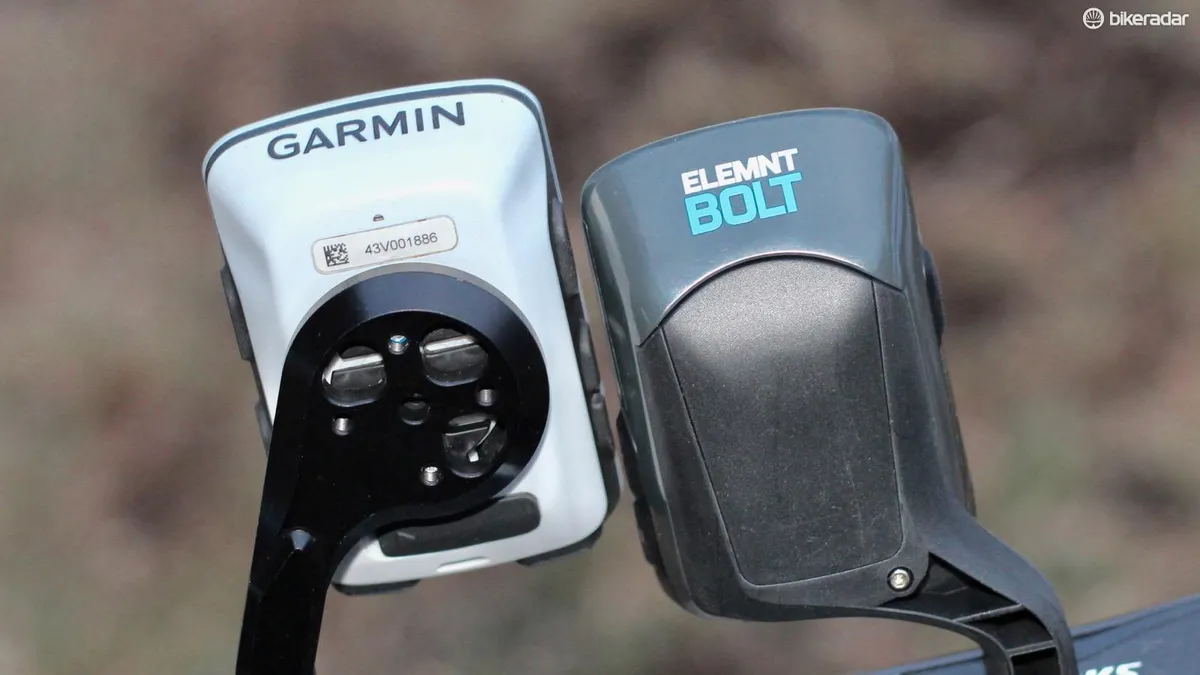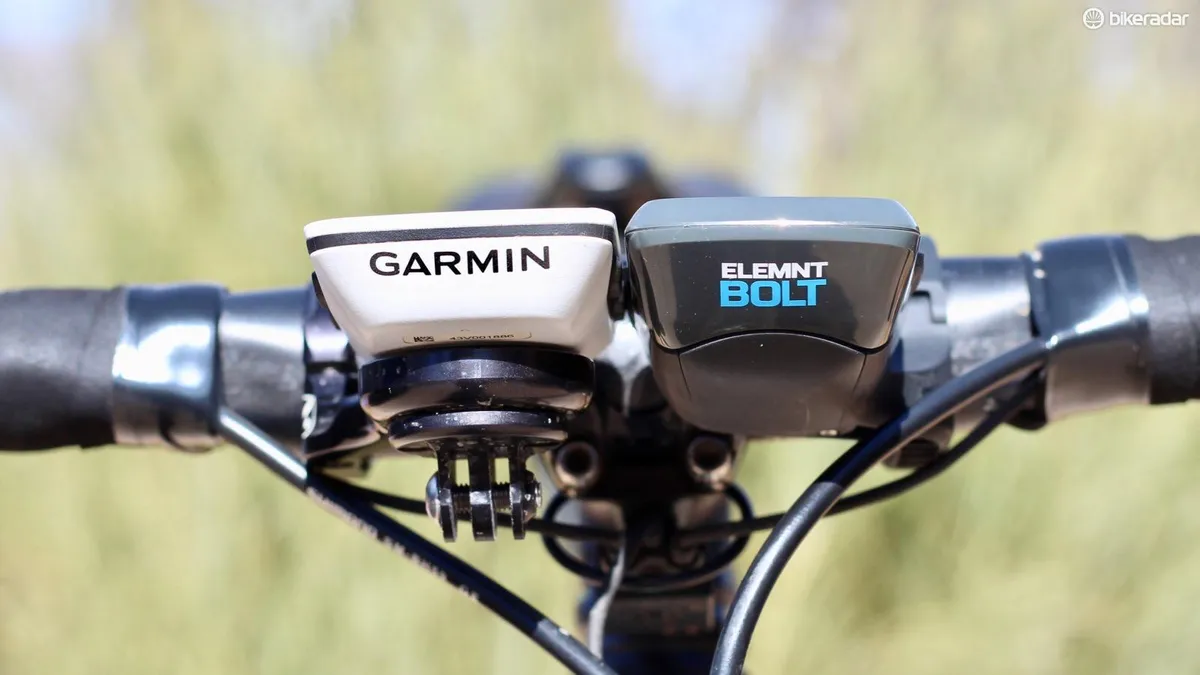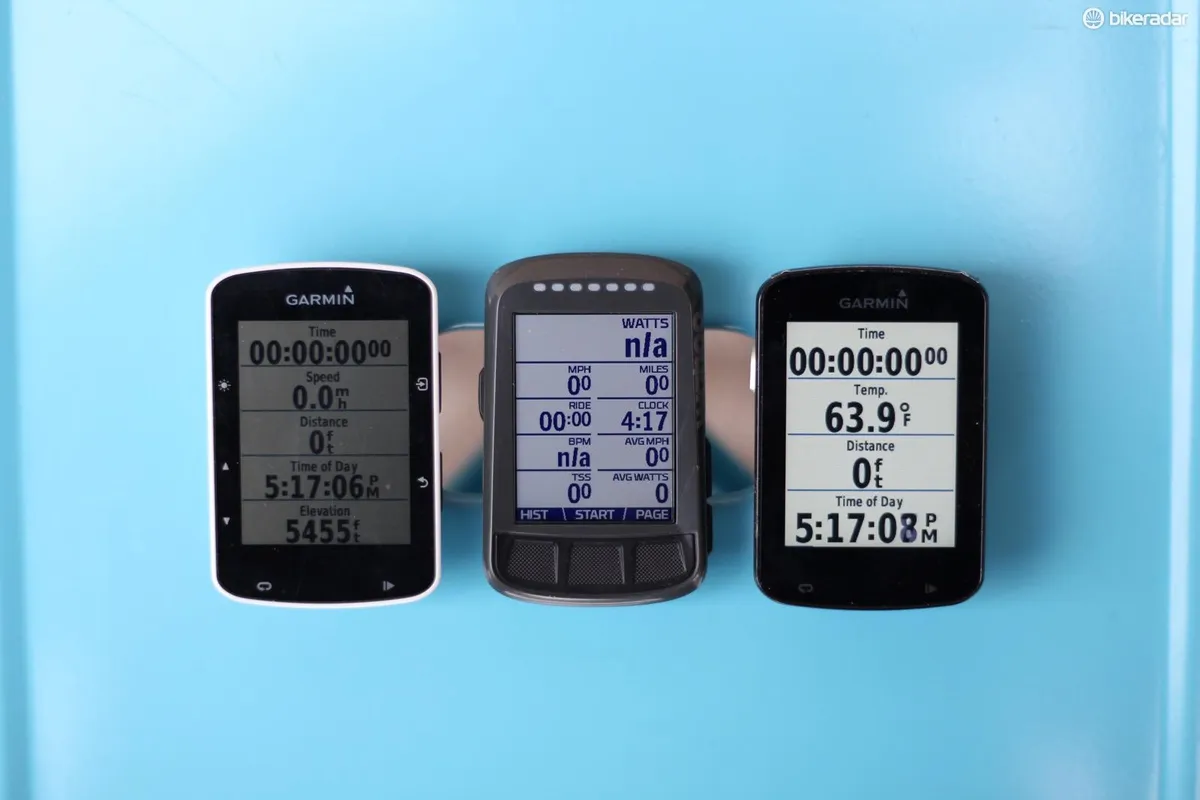Updated 11 June 2018 after Garmin reduced its 520 pricing.
The new Wahoo Elemnt Bolt GPS computer is similar in size, weight and feature set to the popular Garmin Edge 520, but there are a few significant differences in navigation, wireless connectivity and battery life. Also, Wahoo will tell you that the Bolt is much better aerodynamically with its integrated mount than the 520 with a stock Garmin mount.
Here, we look at how the two compare in our Garmin Edge 520 vs Wahoo Elemnt Bolt shootout.
- Wahoo Elemnt Bolt review (4.5 stars)
- Garmin Edge 520 review link (4.5 stars)
- Best GPS computers for cycling
Wahoo, perhaps best known for its Kickr smart trainers, jumped into the GPS computer market with the original Elemnt in late 2015. That large-size unit compared in size, if not exactly in function, to the Edge 1000 of GPS giant Garmin. The new Elemnt Bolt shrinks down in size and in price, without really losing anything from the original Elemnt except screen size.
- Buy the Garmin Edge 520 from Chain Reaction
- Buy the Wahoo Elemnt Bolt from Wahoo Fitness (US)
- Buy the Wahoo Elemnt Bolt from Wahoo Fitness (UK)
Garmin Edge 520 vs Elemnt Bolt central features
The core features of the Edge 520 and Elemnt Bolt are virtually identical: customizable data fields for all the standard metrics of time, distance, elevation, speed, power, heart rate, etc.
Both will pair with your ANT+ peripherals and your smartphone.
Both provide incoming text/call notifications, Strava Live Segments and navigation.

Neither are touchscreen. The Edge 520 has seven buttons, all on the sides. The Bolt has six buttons; three on the face, a power/settings button and two arrow buttons.
Advantage: Neither
Garmin Edge 520 vs Elemnt Bolt pricing
Wahoo undercut Garmin on price compared to the Edge 520 — and even more on the WiFi-enabled Edge 820. Since then, Garmin dropped its pricing to basically match the Bolt in many countries.
Array
Advantage: Now depends on country
Garmin Edge 520 vs Elemnt Bolt navigation
While both computers have navigation, Garmin clearly leads in presentation. The 520's color maps and navigation are much easier to read than the Bolt's black-and-white option. But really, Garmin's years of R&D around navigation best practices is pretty hard to beat.
On both, you can follow a route and still scroll to other screens. When a pending turn approaches, text and arrow notifications will pop up. On the Bolt, you can also set the LEDs to flash at you.
In the Bolt's favor, the thing comes loaded with base maps of most countries in the world in which you might ride a bike. The 520 does not.

Also in Bolt's favor, you can load routes into the computer wirelessly; Garmin requires drop-and-drag with the Edge 520 plugged into your computer with a USB cable.
For both, turn-by-turn navigation requires routes built in to Ride with GPS, Komoot or Garmin's own TCX files. You can use GPX routes, too, like from Strava, but those will only give you a highlighted route on the map, not pending turn directions.
Simply put, for the navigation itself out on the road, Garmin leads the way.
Advantage: Edge 520
Garmin Edge 520 vs Elemnt Bolt connectivity
The Edge 520 has Bluetooth to connect to your smartphone and ANT+ to connect to third-party sensors such as heart-rate monitors and power meters.
The Elemnt Bolt has Bluetooth, ANT+ and WiFi, the latter of which can be used to upload rides and also sync routes and Strava Segments automatically.
While both computers use smartphone connectivity for incoming call and text notifications, plus the live tracking option that lets others see where you are, the Bolt also lets you use the power of Google to search out a destination when out on the bike, and then use your Bolt to navigate you there.

The Bolt setup is done with your phone. After a one-time pairing, you drop and drag which fields you want where with your phone. For its setup, the Edge 520 relies on the traditional method of clicking into and back out of menus and submenus with the computer's buttons.
Finally, the Bolt has the group tracking option on screen, whereby if — and this is a big if — your riding buddies also have Elemnt computers tethered to their smartphones, you can see where they are on your Bolt's screen.
Garmin has a similar feature now on its Edge 820, but not the 520. Both require a clear cellular signal, which as we've all discovered is far from a given when riding bikes, especially in the mountains.
Advantage: Bolt
Garmin Edge 520 vs Elemnt Bolt screen
Both units are roughly 75mm x 50mm, and weigh 60g. Within this, the Edge 520 has a slightly larger screen (2.3in / 58.4mm) compared to the Bolt (2.2in / 55.9mm).
The Edge 520 has a color screen, at 200 x 265 pixels. The Bolt is black and white, but with 240 x 320p resolution.

The Elemnt's unique feature here is the up/down set of arrows on the side of the unit, which lets you zoom in and out on the map, and also to increase or reduce the number of data fields. By reducing fields, the numbers get bigger. This is nice on-the-fly option.
You can scroll forward and backward through data screens with the Edge 520; the Bolt only advances through screens in one direction.
Advantage: Edge 520
Gamin Edge 520 vs Elemnt Bolt battery life
Both units claim 15 hours of battery life. If only that were true.
Claimed battery life is usually clocked on running time without the energy-heavy features such as navigation. In my testing, I find the Edge units to last a little more than four hours with navigation running. I haven't yet exhausted the Bolt on a single ride, but I did a 5.5hr ride with navigation on that only reduced the battery from 96 percent to 55 percent.
Advantage: Bolt
Garmin Edge 520 vs Elemnt Bolt additional features
Garmin has a few features that I classify as educated guesstimates, built by a company called Firstbeat. When used with a heart rate monitor, the Edge 520 will tell you advised recovery time after a ride, and let you know how recovered you are within the first few minutes of each new ride.
When used with a power meter, the Edge 520 can walk you through an FTP test, track your watts/kilo numbers over various durations, and (when using power and HR data) assign you a VO2 max number.

The Bolt's standout physical attribute is the line of color LEDs, which can be programmed for use with navigation or training.
Wahoo also claims the Bolt with its integrated mount is 50 percent faster in the wind tunnel than the Edge 520 with a Garmin mount. Looking at the units, that isn't hard to believe, although a computer is obviously a very small part of the overall drag of the bike and rider package.
Advantage: Neither
Bottom line: Garmin Edge 520 vs Elemnt Bolt overall
Both of these computers are quite good. Garmin still holds the upper hand on execution of navigation, but the Bolt's price, ease of use and modern connectivity put it on equal footing overall with the Edge 520.
In terms of syncing, the Bolt has the upper hand, because you can get routes into the computer and rides out of it with either your phone or your WiFi network. Easy.
For setup, the Bolt is easier to deal with, because you use your phone instead of pressing computer buttons dozens of times to dig down into — and then back out of — menu after menu.
Once set up, however, the units are pretty similar when you're actually out riding. I've come to appreciate buttons over touchscreens on cycling computers, especially computers of this size. Many of us have become accustomed to how well smartphone touchscreens work, and bike computer touchscreens lag well behind. Plus, gloves and sweat and rain all conspire against touchscreens. Buttons just work.
In the Bolt's favor, the zoom in/out buttons work well, giving you more or less data on any given screen without having to pull over and reprogram anything. They work similarly for the map, although you can't scroll in any direction, only zoom.
In the Edge 520's favor, you can move forward and backward through data screens. With Bolt, you can only move forward.
The Garmin maps are much easier to follow, but the Edge 520 poops out at about 4.2hrs. So it's hard to say which is better for serious navigation.
Overall winner: Tie



